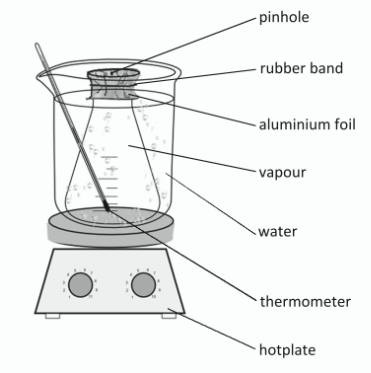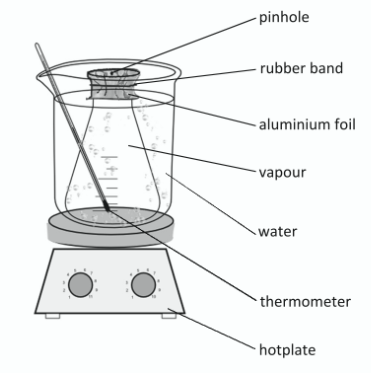To determine the relative molecular mass of a Volatile Liquid
1/11
Earn XP
Description and Tags
CALCULATIONS - gas equations
Name | Mastery | Learn | Test | Matching | Spaced |
|---|
No study sessions yet.
12 Terms
Give an example of a liquid suitable for use in this experiment
Propanone
Draw a large labelled diagram of an arrangement of apparatus you used to carry out this experiment
Conical flask approximately ¾ immersed in beaker of water //
tinfoil lid //
pinhole and rubber band

In your diagram, show
i) how the volatile liquid was vaporised
ii) how the temperature of the vapour was obtained
i) hotplate (bunsen burner, heat source) under beaker
ii) thermometer in water

With reference to your diagram, explain why the pressure of the vapour at the end of the heating stage of the experiment was known to be equal to the atmospheric pressure at your location
Some vapour escaped because of pinhole
With reference to your diagram, explain how the volume of the vapour was measured
Fill the conical flask with water and pour into a graduated cylinder
With reference to your diagram, describe how the mass of the vapour in the container at the end of the heating stage was found
Find initial mass of conical flask, tin foil lid and rubber band. At end of experiment, find mass of conical flask, tin foil lid, rubber band and vapour. Subtract initial mass from end mass
Calculation - 2019 Q3 part d)
Bromine (Br2)(Mr = 160) has a significantly greater relative molecular mass than water (Mr = 18). Account for the volatility of bromine (boiling point 58.8oc) compared to that of water (boiling point 100oc)
Hydrogen bonds in water /
dipole-dipole forces in water /
van der Waals forces in bromine /
intermolecular forces in water are stronger /
intermolecular forces in bromine are weaker /
bromine is non-polar /
water is polar
Volatile
Easily vaporised
Why is this method unsuitable for liquids that are non-volatile?
They do not vaporise easily / boiling points too high / boiling points too near boiling point of water / have to vaporise below 100oc
What modern instrumental technique could be used as a more accurate method to measure the relative molecular masses of volatile and non-volatile liquids as well as of solid and gaseous substances?
Mass spectrometer
How may the pressure be measured?
Barometer